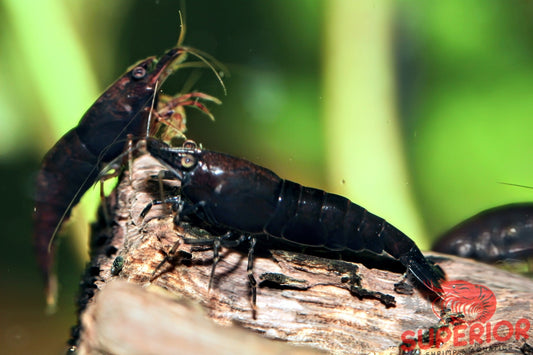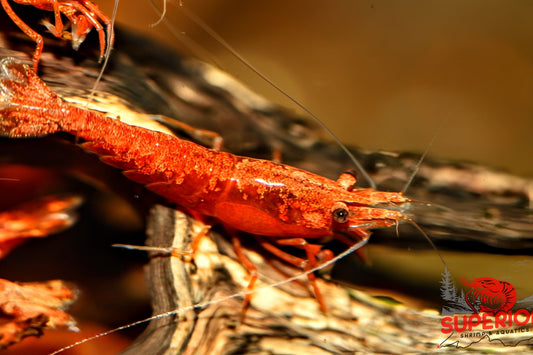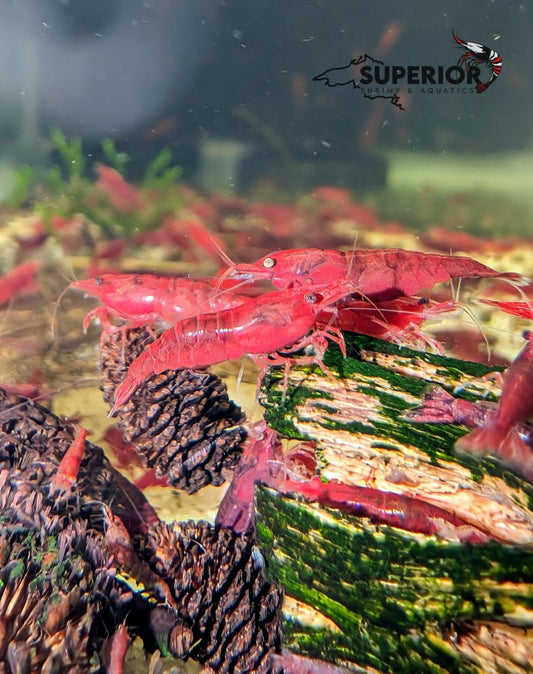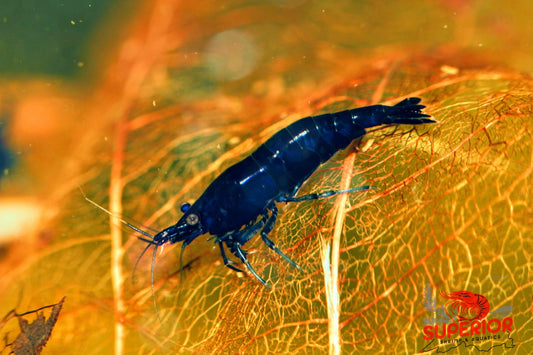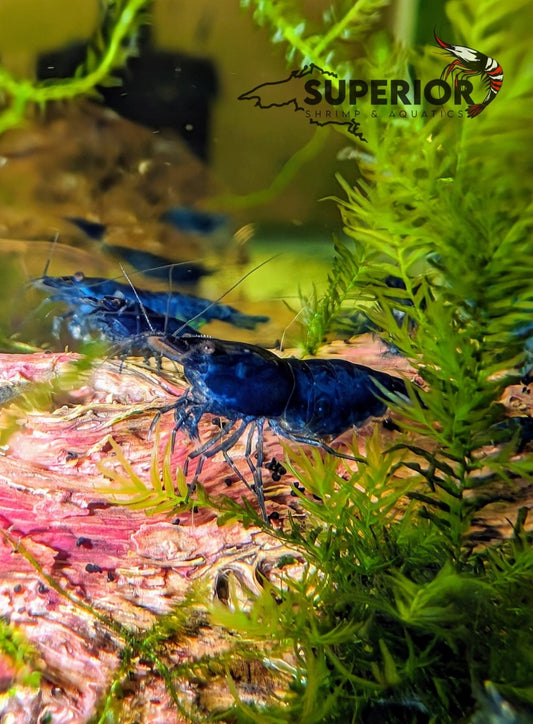Dragonfly nymphs are among the most efficient underwater predators on Earth, yet to shrimp keepers they arrive uninvited, concealed in the living fabric of a thriving aquascape. They are ambush hunters that slip into tanks on plants, pods, or wood, waiting in patient stillness beneath leaves and moss until a shrimplet passes. Once present, they can decimate colonies of Neocaridina Shrimp and Caridina Shrimp within days. This guide, built from entomological research and aquaculture observations, explores every stage of the nymph’s biology, its impact in captive systems, and the precise methods required to prevent, detect, and remove it without harming shrimp or biofilm ecosystems.
The dragonfly life cycle defines the rhythm of freshwater ponds and streams across the world. Adult dragonflies, the aerial acrobats we admire above garden ponds, live only weeks; their aquatic juveniles endure months to years. Eggs deposited in aquatic vegetation hatch into larvae that grow through multiple instars, each molt refining jaws and legs into better tools for predation. Their bodies are built like armored submarines—dense, hydrodynamic, and equipped with a jet propulsion system powered by rectal gills. In aquaria, these adaptations become lethal advantages.
Scientific field surveys, such as Bowles et al. (2022)[1], confirm that nymph abundance increases in habitats rich with submerged vegetation, clear water, and moderate flow—exactly the conditions shrimp keepers cultivate. The coincidence is unavoidable: the perfect shrimp tank doubles as an ideal hunting ground for a dragonfly nymph. The key, then, is not panic but literacy—knowing how the organism functions and how to shift the odds back toward the shrimp.
Egg Stage and Entry into Aquaria
Females of most Anisoptera species insert eggs directly into aquatic tissue, crevices of wood, or in gelatinous chains attached to submerged matter. These eggs are tiny (≈1 mm), adhesive, and resistant to short desiccation, which explains their persistence on shipped botanicals or live plants. If a leaf of Java Moss or a Lotus Pod remains damp in transit, eggs can survive the journey. Once submerged in a stable, oxygen-rich aquarium, they hatch in two to five weeks at 25 °C.
| Parameter | Range | Source |
|---|---|---|
| Egg incubation period | 14–35 days | Priyadarshana et al. 2023[2] |
| Optimal hatching temp | 22–28 °C | Bowles et al. 2022[1] |
| Oxygen demand | >5 mg/L DO | Field aquaculture notes |
A single clutch may yield 100–300 larvae, but only a few will survive in tanks. Even one, however, is enough to destabilize a colony of shrimp. Preventing this initial foothold requires control at the point of introduction—cleaning, dipping, and quarantining every foreign item. The biological rationale is simple: the egg’s developmental clock cannot run without water and oxygen. Drying, oxidation, or prolonged isolation disrupts it.
The Nymphal Machine
Upon hatching, the first instar already embodies predation. Its head houses compound eyes that dominate the skull, tuned to motion and contrast. Beneath, the extensible labium lies folded like a jackknife. Kundanati et al. (2021)[3] recorded labial protraction speeds of 0.05 seconds with peak accelerations exceeding 10 g. Mandible hardness measured by nano-indentation approaches that of glass, enabling penetration of arthropod cuticle.
Table 1. Approximate strike characteristics of dragonfly nymphs
+--------------------------+----------------+
| Metric | Range |
|---------------------------|----------------|
| Extension time | 25–50 ms |
| Strike acceleration | 8–15 g |
| Mandible tip hardness | 5–7 GPa |
| Prey capture success rate | 70–90 % |
These figures illustrate why traditional refuges such as open rock piles provide little defense: a strike at 25 ms renders escape impossible within open water. The countermeasure lies in geometry. Moss, pods, and dense botanicals interrupt both line of sight and the straight path necessary for the labial mask to extend fully. Every stem of Java Moss acts as a speed bump to that motion, diffusing the predator’s reach.
Instar Progression and Growth
Nymphs grow by molting, replacing their exoskeleton roughly every few weeks under aquarium temperatures. Each instar increases body length and predatory scope. Wissinger (1988)[4] quantified consumption rates rising from 0.2 prey day⁻¹ in early instars to over 2 day⁻¹ in late ones at 24 °C. Food availability shortens intervals between molts. In the microcosm of an aquarium, this means that constant access to shrimplets accelerates development.
Table 2. Growth and consumption by instar stage (approximate)
+------------+---------------+------------------+
| Instar | Body length mm | Shrimp taken/day |
|------------|---------------|------------------|
| I–III | 3–6 | <1 |
| IV–VI | 7–10 | 1–2 |
| VII–X | 11–20 | 2–3+ |
Temperature modulates this curve. At cooler values (20–22 °C), molts slow and predation rates drop—a practical lever for shrimp keepers. Many color lines, including Blue Bolts, tolerate mid-70s °F; maintaining tanks at that range subtly suppresses nymph metabolism without stressing shrimp.
Sensory Ecology and Hunting Behavior
Rebora et al. (2012)[5] demonstrated that dragonfly larvae integrate mechanosensory and visual cues: vibration from moving prey, shadow changes, and chemical traces all guide strikes. In tanks with laminar flow and bright overhead lighting, these cues are crisp. By contrast, environments filled with suspended botanicals and irregular flow scatter signals. Each Lotus Pod creates miniature eddies that mask shrimp movement. When combined with the diffuse shading of Java Moss, detection efficiency falls drastically.
In shrimp colonies reared over smooth substrates and open plantings, predation events cluster during crepuscular hours—exactly when shrimp forage most actively. Introducing complexity in both structure and light cycles converts the open hunting field into a maze, where the predator’s advantage erodes.
Entry Vectors and Preventive Quarantine
Every aquarist eventually confronts the paradox that biological diversity and safety oppose one another: every new plant or pod enriches the ecosystem but also carries risk. Field experiments by Ng et al. (2016)[6] in tropical ponds revealed eggs adhering even to desiccated husks for up to ten days. The implication is sobering—dried botanicals are not automatically sterile. Proper quarantine thus extends beyond plants.
A practical approach uses a small holding tank equipped with aeration and a few expendable Ramshorn Snails. These snails serve as living sensors; if a nymph hatches, the population will decline within days. Observing such a test tank under side lighting each night provides early detection without risking core stock. The same principle applies to quarantining driftwood or stones from the Hardscape Collection. Boiling for 15–20 minutes or baking at 200 °F effectively kills eggs, confirmed by aquaculture bioassays.
For living plants, oxidation dips remain effective if carefully applied. A 3% hydrogen-peroxide dip for two minutes followed by immediate neutralization in dechlorinated water is lethal to most insect eggs yet tolerated by hardy species like Java Moss. Detailed chemistry on dip safety and buffering stability appears in your Creating the Perfect Environment for Neocaridina Shrimp guide, which outlines why maintaining consistent KH and pH protects both shrimp and plant tissue during such treatments.
Detection and Diagnosis
The earliest evidence of nymph presence is statistical: a drop in shrimplet survival unlinked to water quality or feeding. Behavioral cues follow—shrimp aggregating in upper strata or avoiding particular zones. Night observation under a penlight angled across the substrate reveals movement that daytime viewing misses. A nymph’s silhouette is unmistakable: squat, broad, with flicking abdomen jets.
Experienced keepers also learn to recognize exuviae—the empty molts often clinging to stems near the waterline. Each indicates a growth event and therefore an unseen survivor. Searching beneath Lotus Pods or between layers of botanicals frequently reveals smaller instars that escaped notice earlier.
Removal Without Chemicals
Chemical control remains inadvisable. Copper, formalin, and organophosphates are all lethal to shrimp at concentrations far below those required to kill nymphs (U.S. EPA 2007)[7]. The safe path is mechanical removal. Techniques include siphoning under dim light, tweezers guided by reflection, or bait trapping. A glass dish with minced shrimp placed at dusk attracts hungry instars overnight; the dish can be lifted carefully next morning and inspected in a white tray. Persistence is critical—nymphs can fast for weeks.
After removal, disassemble major hardscape features and inspect crevices. Rinse Java Moss in tank water to flush out debris; strain through a fine net to catch hitchhikers. Replace habitat elements deliberately, arranging them to favor shrimp cover rather than predator concealment.
Case Studies and Ecological Data
Aquaculture facilities provide natural experiments. In pond-reared tilapia and carp systems, odonate larvae cause measurable fry mortality. Priyadarshana et al. (2023)[2] documented up to 40% losses in unprotected nurseries, dropping below 5% when vegetation density was reduced or exclusion nets applied. Translating to shrimp tanks, the equivalent defense is not vegetation removal but compartmentalized structure—dense cover patches alternating with open feeding zones.
Bowles et al. (2022)[1] correlated nymph abundance with dissolved oxygen and flow: they thrive where oxygen is high and current steady. Adjusting filtration output to create mild turbulence interrupts these preferences without compromising shrimp health.
Table 3. Environmental correlations with nymph abundance
+----------------------+---------------------+
| Variable | Correlation (r) |
|----------------------+---------------------|
| Vegetation density | +0.82 |
| Dissolved oxygen | +0.77 |
| Flow stability | +0.68 |
| Turbidity | –0.45 |
Shrimp Defense Strategies and Population Recovery
After an incursion, rebuilding colony numbers requires patience. Surviving adults may hesitate to breed for weeks after stress events. Introduce fresh biofilm surfaces with new Botanicals and supplement with mineral-rich Food & Supplements designed for molting recovery. Allow plants like Java Moss to regrow naturally; their filamentous mats harbor microfauna essential to juvenile survival. Maintain moderate feeding so leftover proteins do not draw additional pests such as planaria.
Long-Term Prevention Philosophy
Ultimately, dragonfly nymph management mirrors broader biosecurity principles. Every object added to the aquarium is either sterile, quarantined, or suspect. Quarantine tanks should be as routine as water changes. When importing new decorative materials from the Hardscape Collection or fresh Lotus Pods, assume potential contamination until proven otherwise.
Maintaining water chemistry also plays a subtler role. Stable KH and GH prevent physiological stress in shrimp, keeping them active and less prone to nocturnal lethargy—times when predation risk spikes. As detailed in your Creating the Perfect Environment for Neocaridina Shrimp guide, buffering stability provides not just shell strength but behavioral resilience.
Summary of Key Biological Traits
Table 4. Dragonfly nymph biology summary
+---------------------------+----------------------------+
| Trait | Typical Value/Range |
|---------------------------|----------------------------|
| Development duration | 4–12 months |
| Instars | 8–15 |
| Preferred temperature | 22–30 °C |
| Strike range | 0.5–1.5 cm |
| Diet breadth | Omnivorous carnivore |
| Respiration type | Rectal gills (jet-propel) |
Each value explains part of the management puzzle: long development means extended risk; temperature flexibility means they survive most aquaria; broad diet means shrimp are always viable prey.
Ethics and Ecological Context
While nuisance in captivity, dragonfly nymphs remain keystone predators in the wild. Their presence signals clean, oxygenated water. Removal should therefore focus on prevention and containment, not eradication campaigns beyond the aquarium. Never release captured nymphs into local waters; species transported through trade may not belong to the regional fauna. Disposal by freezing or alcohol immersion is humane and ecologically responsible.
Closing Perspective
Every shrimp keeper eventually learns that the invisible ecosystem matters more than the visible one. Dragonfly nymphs exploit that truth by living unseen until they have already succeeded. Understanding their life history converts fear into method. A tank layered with Java Moss, dotted with Lotus Pods, fortified with structure from the Hardscape Collection, and enriched with Botanicals becomes both aesthetic and defensive. Knowledge, not panic, is the aquarist’s best tool—supported by patience, observation, and the right materials from Superior Shrimp & Aquatics.
Footnotes & Sources
[1] Bowles D. E., et al. (2022). Environmental determinants of dragonfly nymph distribution in eastern Texas streams. MDPI Water 1(1):6. https://www.mdpi.com/2673-9917/1/1/6
[2] Priyadarshana T. S., et al. (2023). Predation rates of odonate naiads. J. Animal Ecology. https://besjournals.onlinelibrary.wiley.com/doi/10.1111/1365-2656.13965
[3] Kundanati L. S., et al. (2021). Prey capturing dynamics and nanomechanically graded cutting apparatus of dragonfly nymphs. Scientific Reports 11:3712. https://pmc.ncbi.nlm.nih.gov/articles/PMC7865395/
[4] Wissinger S. A. (1988). Life history and size structure of larval dragonfly populations. J. N. Am. Benthol. Soc. 7(1):13–28. https://www.jstor.org/stable/1467917
[5] Rebora M., et al. (2012). Visual and mechanical cues used for prey detection by larvae of Libellula depressa. Ethology Ecology & Evolution 24(4):341–349. https://www.tandfonline.com/doi/abs/10.1080/03949370.2012.698376
[6] Ng T. H., et al. (2016). First non-native establishment of the carnivorous assassin snail Anentome helena in Singapore. BioInvasions Records 5(3). https://www.reabic.net/journals/bir/2016/3/BIR_2016_Ng_etal2.pdf
[7] U.S. EPA (2007). Aquatic Life Ambient Freshwater Quality Criteria – Copper (Revision). [
